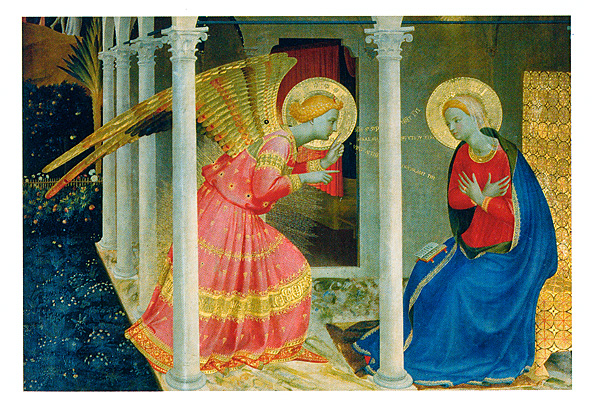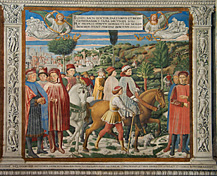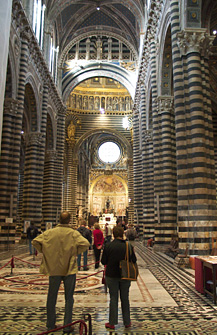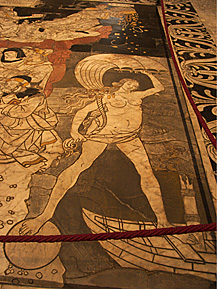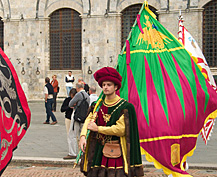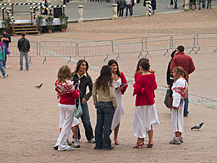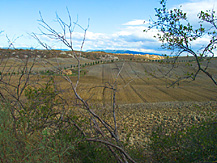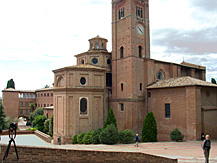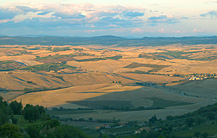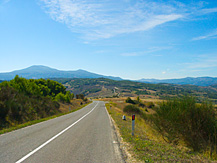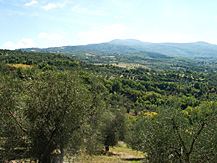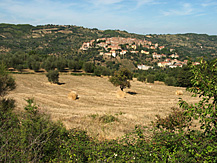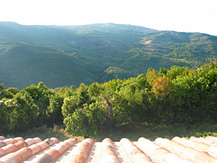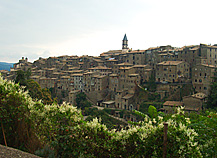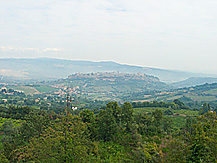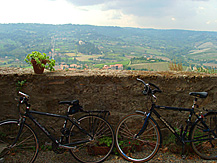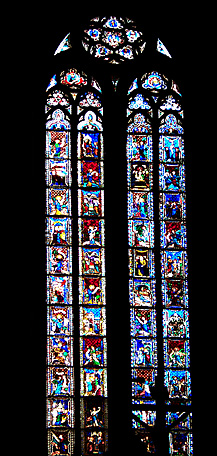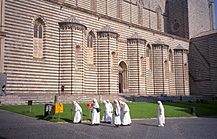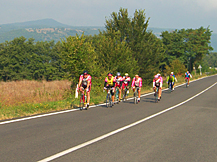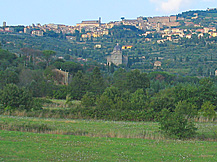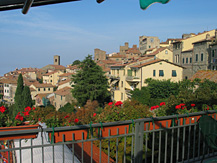
Last trip: May 2004
This page last updated on: September 12, 2012
How to bicycle the hill towns of southern Tuscany and Umbria -
Organize your own cycle tour, or join a commercial bike trip.
Difficulty: Medium to Hard, with a few easy spots Bike Rating: Excellent
Nature of the Ride: The hill towns and valleys of southern Tuscany and Umbria provide a wonderful cross-section of Italy's charms. The picturesque hill towns, filled with ancient houses and churches of medieval architecture, offer striking views, as you while away the warm evenings, observing attractive Italians enjoying life to the full -- eating, drinking, often dressing up in the latest styles, and engaging in conversation with friends.
Olive groves and vineyards dot valley slopes, while vegetables, wheat and hops grow on the valley plains. The sun shines intensely in the polution-free air of this ride. The bonus of your Tuscany-Umbria biking holiday will be the awe-inspiring Renaissance paintings and frescoes—many of which count as great masterpieces.
Below: Autumn southeast of Siena

You will cycle on well-paved, smooth, almost pothole-free roads. In all probability, car and truck drivers who pass will give you a wide berth. (The courteousness came as a surprise to the author, familiar with daredevil, almost reckless, Italian speedsters that course along the Italian autostrade superhighways.) If you choose to ride on main highways, you will encounter low to moderate-volume, high speed truck and automobile traffic, but ride on wide smooth shoulders. Minor roads, by contrast, are somewhat narrow, sinuous, and hilly, but carry very little traffic. The only concentrations of traffic during the author's trip were near and in the three cities he visited: Florence, Sienna, and Perugia. None of these concentrations was excessive or threatening.
Terrain in the valleys is flat to lightly rolling. The hills range from gradual to very steep—steep particularly in the Chianti region south of Florence. Don't be surprised if you walk your bike from time to time. If you choose to cycle in the major valley roads, such as Route 2 (the Via Cassia from Florence to Siena to Rome) or 397 from Todi to Perugia along the Tiber River, you will cover greater distances with more ease, but experience more traffic, some industry, more ugly, modern construction, and less exciting views.
The famous Tuscan and Umbrian hill towns are accessed by long, steep climbs of 600 to 1,500 feet. Usually the road to these towns will be pitched at under 8%, and are rideable if you are reasonably fit. Some hill towns, however, are accessed by pitches close to 12%. Unless you are extremely fit, you will need to push your loaded bicycles. If you choose to cycle through the hills your progress will be much slower and your lungs and legs will be tested, but you will see wonderful old towns and striking vistas, and experience long, exciting descents at high speeds. Where possible, the author strongly recommends the hills, or, if in valleys, minor roads alongside lakes.
Please refer to Bicycle
Touring in Europe for important background on touring styles,
transportation, bike types, advisiblity of rentals versus bringing your own bicycle, maps, information sources,
traffic ratings, packing, and security and safety tips.
Star symbols in the
text show ratings given by the Michelin green guide books, which
the author likes and uses. Three stars mean worth a journey; two,
worth a detour; and one, interesting.
Below: The hill town of Montalcino.
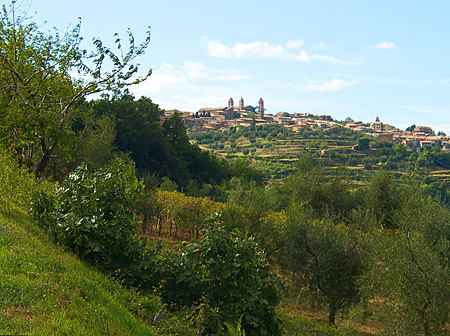 When
to Go: Late spring and early fall are the ideal times to undertake
a Tuscan -Umbrian adventure. The summers are quite hot, rising into
the mid-80's in summer; and in August the countryside is jammed
with vacationing Italians and foreigners. Late fall is rainy, and
winter is cold— with highs in the mid 40's, and at higher elevations,
a risk of snow. May, early June and September and early October
are the ideal months to bike.
When
to Go: Late spring and early fall are the ideal times to undertake
a Tuscan -Umbrian adventure. The summers are quite hot, rising into
the mid-80's in summer; and in August the countryside is jammed
with vacationing Italians and foreigners. Late fall is rainy, and
winter is cold— with highs in the mid 40's, and at higher elevations,
a risk of snow. May, early June and September and early October
are the ideal months to bike.
Unfortunately, many hotels are likely to be full, and must be reserved at least several weeks ahead of time.
Major Attractions: So many attractive and charming hill and valley towns are dotted around Tuscany and Umbria that you can virtually plan your itinerary at will. However—assuming you love art and architecture—there are a handful of wondrous places in the region that you will never forget, and they should carefully be considered for inclusion in any ride (Stars are Michelin Green Guide ratings) :
Florence (Firenze)***: While the author's acquaintances are divided upon the beauty of the city itself, all agree that the art there is unbeatable. There is probably no place in the world where the Renaissance art is of equal quality. Five or six full days ares necessary to see the most important masterpieces. Florence also contains numerous fabulous churches, museums, palaces and gardens. In Florence the author admires particularly the Boticelli's in the Uffizi Museum, the Cathedral, and the San Marco Monastery full of Fra Angelico's frescoes.
Siena***: Almost everyone feels emotionally moved by Siena, its scale, its colors, its completely medieval appearance, the wonderful Piazza del Campo that teems with life. The organization and cultural life of Sienna is truly unique, completely organized around the running of the palio on July 2 and August 16, with preparations and aftermaths filling the rest of the year. The palio is a horse race around the Piazza del Campo with entries from each of Sienna's 17 Contradas (districts of the city with their own flags and colors, clubs and self-help associations). All Sienans wear medieval costumes and carry medieval weapons. Hotel space is impossible to find in the area during the Palio, and very difficult at any other time, so plan ahead. The author was fortunate, in late September, to witness an award presentation in the Piazza del Campo giving recognition to the best Palio drummer and the best flag wavers. All the 17 Contradas' drummers and flag wavers (with their flags waving) —in different medieval colors—participated in the ceremony.
Not so far from the Piazza del Campo is another sight that should not be missed. In the interior of the cathedral are stunning frescoes and incredible inlaid marble floors, the work of many celebrated artists.
Children watching a ceremony in Siena.
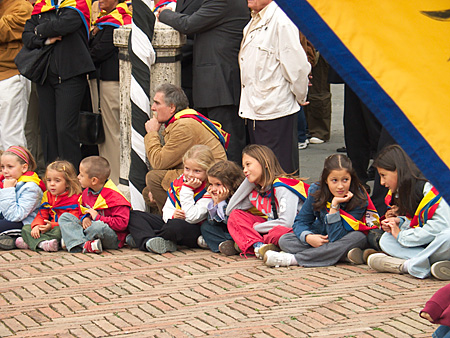 San
Gimignano*** : The main draw of San Gimignano is the series of a
dozen medieval towers that dominate the town, and the original
medieval walls. Most Tuscan medieval towns had such towers and walls, but they were
torn down. Outstanding frescoes are to be found in the cathedral.
San
Gimignano*** : The main draw of San Gimignano is the series of a
dozen medieval towers that dominate the town, and the original
medieval walls. Most Tuscan medieval towns had such towers and walls, but they were
torn down. Outstanding frescoes are to be found in the cathedral.
Assisi***(Umbria): The "must see" of Assisi is the Basilica di San Francesco (St. Francis Basilica), composed of an upper and lower church. Both are covered with fabulous 13th and 14th century frescoes by Masabue and by pupils of Giotto. In an oak forest 4 kilometers south of town lies the delightful Ermo (hermitage) delle Carceri. Within an hour's bike ride of Assisi there are several other very interesting sights.
Monte Oliveto Maggiore**: This abbey lies more-or-less on the route from Siena to Montalcino. The cloisters contain wonderful frescoes illustrating the life of Saint Benedict, by Signorelli and Sodomo. The abbey church has wonderful inlaid stalls, made by Fra Giovanni Di Verona. The abbey is closed from noon to 3:30 PM, so get an early start from Sienna (or other starting point). There are some lodgings a few kilometers away, should you care to spend the night in the area.
Pienza**: The cathedral contains several wonderful paintings, but the main reason to visit this town is the unity of its architecture, which followed a plan commissioned by the humanist pope, Pius II, in the early 15th century. It was meant to be the ideal town, and some say it is the first instance of a complete town plan.
Montepulciano**: All the hill towns are charming, but many think that Montepulciano is the among the most charming. The tower in the main square has a wonderful view of the surrounding countryside.
Orvieto** (Umbria). The author's favorite hill town (but there many hill towns remaining to be explored). The striped and "curled" and painted exterior of the Cathedral is stunning. Don't miss the Modonna di San Brizio chapel in the Cathedral (tickets are purchased in the Tourist Office) with the frescos of Fra Angelo and Luca Signorelli. The underground tour of the quarries is also quite interesting. Orvieto streets are attractive, and the vistas from the ramparts, breathtaking.
Todi**(Umbria): (Not personally visited by the author.) Todi is another of those completely charming medieval hill towns with many interesting monuments and a great view. Some of the town walls date back to Etruscan and Roman times
Perugia**(Umbria): The center of this sizable city, the capital of Umbria, is wonderful, but to get there you must ride endlessly uphill through less-attractive modern suburbs. Highlights include the central-city streets and squares, shopping, and the museum "Galleria Nazionale dell'Umbria", which includes some fabulous paintings by Perugino. Should you feel a pang of uneasiness in Perugia—because five popes were assassinated here?
Below: "The Annunciation" by Renaissance painter Fra Angelo, in the Cortona museum.
Cortona**: The art gems of this charming town are found in a rarely visited museum across form the cathedral. It contains two fabulous paintings; one by Signorelli (who was born here), and the other, "The Assumption", by Fra Angelico. Two walks are highly recommended: The first up to the church on the top of the hill called the Santuario de Santa Margherita, with a return on the opposite side of town; and the second, a 45 - 60 minute walk clockwise around the hill, past the home of the author of "Under the Tuscan Sun", by the tennis courts, and arriving back in Cortona through the park.
Arezzo**:The main attractions are the main square, the Piazza Grande, surrounded by medieval houses, and the San Francesco Church, which contains a series of incredible Renaissance frescoes telling the legend of the true cross. Arezzo is a large town of 100,000 inhabitants, and there can be substantial traffic.
Not considered top sites, but well worth a visit, these all lie in the south of Tuscany:
Bagno Vignoni: A tiny village below Montalcino, with famous hot springs. The old hot springs in the town square are polluted looking. You can swim at the pool of the hotel, which takes its water from the same source, for a modest charge, or in a natural pool down in the valley below the hotel.
The mountains of San Quirico, Monte Amiata, Monte Civitella, Monte Calvo, and the surrounding countryside.
Pitigliano: This once-Etruscan town, completely off the beaten track at the southern limit of Tuscany is worth visiting for its incredible fortress-like site, its views, and its medieval layout (though with public buildings from the Renaissance). The self-guided tour of the Jewish Synagogue is fairly interesting. Nearby Sorano also has an intersting layout, and at Savana there are Etruscan tombs.
Capalbio:(not visited by bicycle) For lovers of very modern art, this town is even more off the beaten Tuscan track, in the hills above the sea in the southwestern most corner of Tuscany, much closer to Rome than to Florence. The chief attraction is the unique "Giardino dei Tarocchi", the Garden of Tarots by Niki de Saint Phalle. Many of the bright sculptures are hollow: one was the artist's summer home.
Many other hill and valley towns have their charm: Castellina in Chianti, Radda in Chianti, and Montalcino, to name but a few.
Wine and Food:
You will encounter the following wines in southern Tuscany and western Umbria: Chianti Classico (red or white)(in Chianti, obviously-- the area between Florence and Sienna); Brunello (around Montalcino, red); Vino Nobile (from Montpulciano, red); Vin Santo (white); and Vernaccia (from San Gimignano ,white).........and in Umbria, Orvieto (white) and Verdicchio (white). The author's advice would be to stick mainly with the lower priced, ordinary wines. Most of the expensive wines he has tasted there were no better. The exception, a wonderful and costly wine in each of 3 different years tasted was Fanterutoli from Castellino in Chianti.
In most towns, it is impossible to eat anything but traditional Tuscan and modern Italian food. Forget French, Chinese, Thai or American cuisine. Do you care? Not the author. You will eat well, and even wonderfully well if you choose carefully with local advice. In Tuscany and Umbria, pasta is almost always homemade and delicious, and for some unknown reason better than the fresh pasta we can find in the United States. Consider avoiding restaurants that don't make their own pasta. Vegetables are very fresh. Italian coffee is dark, strong, and very tasty.
When it comes to ordering, the author suggests that you try everything. The author's favorite—his strongest food memory from his trip without doubt, were the various creations using porcini mushrooms (available in autumn) and sauce over homemade pasta.
How to bike it: Chose among very many organized groups with varied itineraries,
difficulties, and degrees of luxury, or organize the trip yourself.
Organizing a Tuscany - Umbria bike trip yourself:To print itinerary, select the text below, and choose 'print selection'. Please follow this link for an explanation of the author's traffic ratings. Maps: The author strongly recommends that you acquire 1:200,000 maps for this ride, specifically the two maps for Toscana (Tuscany) and for Ombria (Umbria) published by the Touring Club Italiano and/or (they are identical) by Kümmerly & Frey. These can be purchased online, or in stores in Italy. You may want to cut out the sections of each map that are relevant to your planned trip, as they are both rather heavy and bulky. You will need to discern all the information you can from the maps, in order to properly plan your trip, and this is a bit difficult. There are no topographic lines, but, as you can easily imagine, changes in elevation and road steepness are critical in estimating how much you can cover. Carefully look at the elevations of hill towns, given on the maps. Look for little chevrons (arrow tails, ">") along the highways. One means the slope is more that 4%, two together, more than 7%, and 3 together, more than 12%. (Unfortunately, not every very steep slope is marked.) If a highway wiggles back and forth, it may well be switchbacks. Language: Outside of the hotels, most people won't speak much English. Even in tourist restaurants, English knowledge can be limited to the items on the menu. (Often, but not always, menu's are available in English.) You might want to take a few private Italian lessons, or study a phrase book, to learn how to pronounce written Italian, and basic words for travel. Italian road signs are usually self-evident, but none-the-less, you are going to need to ask directions once in a while, if only to find your lodging.. If you can't ask, try pointing at a map or a written hotel name. People in Tuscany and Umbria are very friendly and helpful. The most important pronunciation rule to remember is that "h" usually has the opposite function compared to English. That is, a "c" (with no "h") before an "e" or "i" is pronounced as English "ch", for example in the word "bici" (bike) pronounced"beechee" and "bicicletta" (bicycle) pronounced "beecheecletta". When an "h" does occur in an Italian word before an "e" or "i", it turns the sound to the English "k". For example, "chiesa" (church) is pronounced "kiesa". (If in Italian a "c" occurs before an "a", "o", or "u", it is almost always pronounced "k".) Lodging: If you go to Tuscany in the late spring, summer or early fall, you will find most lodgings are sold out by the end of the day, and often days or weeks before. As much as it is preferable in principle to "play it by ear", on this trip usually you must reserve your lodgings ahead of time. Few things could be worse than arriving in a hill town at the end of the afternoon, after a long day and an arduous climb, to find that there is nowhere to stay. Also, in autumn, night falls by six-thirty p.m., and on a long day you may not be able to ride somewhere else, except in the dark—if you have head and tail lights! Sources for hotel (hotel or albergo) names include regional guide books, hotel guides, and the Internet. You can just take your chances with hotels, or you can spend hours and hours researching your best choices. It is up to you. The author prefers to telephone the hotels in Tuscany and Umbria he wishes to reserve. If they are already full, he learns it instantly, and he confirms the room prices. Most hotels speak or understand some English. "Bed and breakfasts" exist in the region, as well as a large choice of "agriturismo". An agriturismo is, in theory and usually in practice, a rural farm that takes guests for sleeping and breakfast. Dinner with the farm family is often possible with advance notice. For a complete list of the hotels and lodgings available in Tuscany (but not Umbria), the site http://www.agriturismi-toscana.com is highly recommended. Camping is an alternative, though campgrounds are usually away from the tourist centers. The author has no expertise camping in Italy. Renting: There are several shops in Florence (Firenze in Italian) renting a selection of bicycles that include: city bicycles, mountain bikes, hybrids, and racing bikes. To locate a rental company, perform an Internet search using the terms "noleggio bici firenze". Bicycle Repairs: Apart from the main cities, bicycle shops are few and far between. Locals of the hill towns do not often ride bicycles. The cyclists you will see in the hills are usually on a day ride out of the larger cities such as Florence, Sienna, or Perugia, or are bike-touring foreigners. The author was unable to find common biking supplies, such as tubes, in any of the hill towns. In the valley, a bike shop is said to be in the charming market town of Buonconvento (north of Montalcino), and a large bicycle sales and repair operation may be found on the south end Marsciano between Todi and Perugia (but you probably won't see it from the road; it is on the west side in the back). Ask for directions. Recommendation: bring spare parts with you. Bicycle Vocabulary
Getting to your Starting Point: If you are arriving in Italy by airplane from the United States, you will land probably in Milan or Rome. From these, you can fly into Florence (Firenze), or you can fly to Florence from Paris and perhaps a few other European destinations. Flights from London and Frankfurt do go into Pisa. From Pisa you can get to Florence in about an hour by train or in a day by bicycle. You can also take a train from the Rome airport to the Rome central railroad station. From there, trains to Florence depart fairly frequently, taking just over an hour and one-half to make the trip. If you want to take an assembled bicycle on the train from Rome to Florence, then count on spending over three hours for the journey. Although trains throughout Italy carry assembled bicycles, these trains are regional, and slower speed. As a practical matter, if you are coming from France or Germany to Tuscany or Umbria, as when you are flying in from the United States, it will be most practical to bring your bicycle dissembled in a bag or box. If you are planning a circular trip, you can leave a box, bike suitcase, or heavy commercial bike bag at a hotel or possibly at the baggage check of a train station (but the author believes the time allowed for storage will be too short). Better to make you own (or have made for you) lightweight, foldable bike bag of heavy ripstop nylon. (See the author's directions for making one, called a housse in French, on this page.) The author has used his bike bag on four trips now, and it is still going strong. If you are traveling by train, there's no need to start in Florence. You can pick any spot along the train lines. If you are arriving by air, you could consider beginning your cycling from Rome. This is, really, a different trip, quite beyond the author's experience in Tuscany and Umbria. The circuit below—that the author and his girlfriend accomplished in 10 riding days—assume that you will be starting in Florence. Two (2) additional days would be required to get back to Florence. The circuit goes farther south than most tourists go. You will find, therefore, suggestions for a shortcut across the loop that saves 4 riding days. Take these circuits only as suggestions. There are probably 100 ways to put together an interesting cycling itinerary in Tuscany and Umbria. Circuit: Comments below in italics are copied from the "Major Attractions" section above. Day 1: Florence*** - Castellina-in-Chianti.While the author's acquaintances are divided upon the beauty of the city itself, all agree that the art there is unbeatable There is no better place in the world to see Renaissance art; five or six full days is necessary to see the most important masterpieces. Florence also contains numerous fabulous churches, museums, palaces and gardens. In Florence the author admires particularly the Boticelli's in the Uffizi Museum, the Cathedral, and the San Marco Monastery full of Fra Angelico's frescoes. Start your trip from Florence (Firenze) by mid morning. If you are not departing by mid-morning, plan on cycling only as far as Greve in Chianti. If you are arriving by air, you should consider taking a taxi to the south side of the Arno river, and assemble your bicycle and pick up the routing there. If you arrive at the train station, assemble your bike(s) on the platform or elsewhere near the station. Get a tourist map of the city from the tourist office in the station (at a nominal price). Following any of a number of one-way streets, cross to the south side of the Arno River, and make your way to the Piazzele di Porta Romana, which is almost due south of the railroad station at the southwest end of the Boboli Gardens. Follow the Via Senese SSW about 5 kilometers, until you cross a little stream. Turn left. (This turn is about 2 kilometers before the autostrade.) In somewhat over 1 kilometer, this road will turn right (signs for Impruneta (and perhaps Greve). You climb out of the Arno river basin. After Impruneta you join Highway 222, which you follow south to the Greve in Chianti. Traffic is likely to be light. The attractive piazza of the town is just to the west of the highway. You might well want to stay in Greve, as the 20 kilometer ride to Castellina is daunting. (If you do stay in Greve, you might wish the next to day to ride to Castellina via Radda-in-Chianti.) After Greve you climb a hill through Campana, only to descend again. Then, for 9.5 kilometers, you make a very steep climb 1,000 foot to Castellina, sections of which are probably too steep to ride.. Castellina has a choice of two Michelin one star restaurants and some excellent wines. Day 2: Castellina - San Gimingano***. The efforts of yesterday will have brought you "up". Today, it takes no effort at all to go "down". Be careful on leaving Castellina not to take the wrong road; it is a bit confusing. Take the road (429) which goes due west to Poggibonsi. This descends, at a constant slope, in very light traffic, for 20 kilometers! Cross the autostrade, and turn left at the T junction (heading south). Cross (traffic circle??) the main road and follow signs to San Gimignano, climbing 9 or 10 kilometers. Traffic is likely to be moderate. The main draw of San Gimignano*** is the series of a dozen medieval towers that dominate the town, and the original medieval walls. Most medieval towns had such towers and walls, but these were torn down. Outstanding frescoes are to be found in the cathedral. Day 3: San Gimingano*** to Siena***. Descend from San Gimignano on the same road that you arrived on. About one-half of the way back to Poggibonsi— where after a relatively straight spell the road curves strongly to the left—turn right on the road for Bibbiano. Climb up the hill, and then descend a bit to highway 68, where you turn left for Colle di Val d'Elsa. From here take the highway to Monte Riggioni, which is about 23 kilometers from San Gimignano. Now you ride along Highway 2, the Via Cassia, to Sienna, about 20 kilometers. This section of Highway 2 is quiet, due to the parallel Autostrade. It winds and undulates through a forest, then climbs the hill upon which Siena is located. Consider spending 2 nights in Siena. Siena is without doubt a highlight of the trip. Almost everyone feels emotionally moved by Siena, its scale, its colors, its completely medieval appearance,the wonderful Piazza del Campo teems with life. On July 2 and August 16 the Palio takes place—a horse race around the Piazza del Campo with entries from each of Sienna's 17 Contradas (districts of the city with their own flags and colors, clubs and self-help associations). All Sienans wear medieval costumes and carry medieval weapons. Hotel space is impossible to find in the area during the Palio, and very difficult at any other time, so plan ahead. The author was fortunate, in late September, to witness an award presentation in the Piazza del Campo giving recognition to the best Palio drummer and the best flag wavers. All the 17 Contradas' drummers and flag wavers (with their flags waving) —in different medieval colors—participated in the ceremony. Not so far from the Piazza del Campo is another sight that should not be missed. In the interior of the cathedral may be found stunning frescoes and incredible inlaid marble floors. Day 4: Siena to Montalcino. Be sure and get an early start if you want to see the Abbey of Monte Oliveto Maggiore**, which closes from noon to 3 PM. Moreover, the restaurant nearby can easily be full if you don't arrive promptly at noon. Leave Siena by the road to Sinalunga, highway 326. After about 7 kilometers (depending upon where in Sienna you start from) turn right onto highway 438, which leads to Asciano (pronounced like "ahshiano"). The road climbs to the ridge of a hill, and follows the ridge line as it makes right and left turns with views to nearby hills—it is one of the prettiest rides of the entire trip. You can get to the Abbey by branching right just before Asciano; or if you have a bit more time, you can take a look at Asciano, and exit in the direction of Trequanda, turning right for Montefresco and the Monte Oliveto Maggiore Abbey** (about 6 kilometers longer). The cloisters contain wonderful frescoes illustrating the life of Saint Benedict, by Signorelli and Sodomo. The abbey church has wonderful inlaid stalls, made by Fra Giovanni di Verona. From the Abbey, ride downhill to Buonconvento, a charming market town (just to the West of the main highway 2 Then follow highway 2 to the road for Montalcino. After descending to a river, this climbs incessantly, but at a bikable grade, until it reaches the town. Day 5: Montalcino to Bagno Vignoni. From Montalcino to Bagno Vignoni it is only a 9 kilometer high-speed descent followed by a 12 kilometer easy ride in the wide breakdown lane of highway 2, the Roman Via Cassia, which is the main route between Siena and Rome. (Traffic, however is no more than moderate.) Thus, without detours, this is a 90 minute day. In Bagno Vignoni, if you have a swimming suit with you (or using your biking attire as a swimming suit) visit the hot-spring-water swimming pool at the main hotel of the town (modest fee); or you may walk down the hillside below the hotel to a natural pool fed by the same water. The pool in the town square is not for swimming. On this day the author's original plan was, after descending from Montalcino, to bike up the steep road which leads from San Quirico d'Orcia to Pienza** and then down to Bagno Vignoni. (Bike trouble derailed this plan.) In Pienza**, the cathedral contains several wonderful paintings, but the main reason to visit this town is the unity of its architecture, which followed a plan commissioned by the humanist pope, Pius II, in the early 15th century. It was meant to be the ideal town, and some say it is the first instance of a complete town plan. If you wish toshorten your trip by 4 days, after reaching and visiting Pienza, continue on, and spend the night in Montepulciano. All the hill towns are charming, but many think that Montepulciano is the among the most charming. The tower in the main square has a wonderful view of the surrounding countryside. The following day, ride from Montepulciano to Cortona** (described in Day 11, below) , either directly, or via the charming lakeside town on Lago Transimeno called Castiglione del Lago. Day 6: Bagno Vignoni to Selva (south of Santa Fiora). This challenging day takes you up and then down many steep hills. The final destination was an agriturismo (farm lodging), which provided a wonderful change of pace from hotels. It was run by a very sympathetic older couple, who served a tasty dinner and fine breakfast. It might be a better break point, however, to stay a bit farther north, in Arcidosso, for example, particularly if visiting Monte Amianto (see below).. From Bagno Vignoni you ride back downhill to highway 2, turn right, (south) and after crossing a river bridge, turn right again immediately on highway 323 overlooking Bagno Vignoni. After climbing to Castiglione d' Orcia, you coast for kilometers in a pleasant descent to Ansidonia. There are constant climbs and descents as one passes through Segiano, Castel del Piano, and Arcidosso. After Arcidoso the terrain changes from farmland to woods. From this point until Pitigliano, at the end of Day 7, the ride is essentially through the mountains. Some riders may wish to cycle up to Monte Amiata (1,7338 meters - about 5,800 feet). Towns are poorer, and with fewer facilities for travelers The agriturismo where the author stayed was approximately 8 kilometers south of Santa Fiora. Day 7: Selva to Pitigliano. This day is a relatively easy and flat ride, with a few ups and downs, capped by a steep descent and a steep climb into Pitigliano. Not far off the way are the interesting medieval town of Sorano, and the Etruscan burial sites at Sovana. The final climb into Pitigliano gives unforgettable views. Pitigliano is not considered a major tourist site, but in fact enjoys one of the most striking views of any town the author has ever visited, both up from below, and down from above. (see description in "major attractions"). There is only one decent hotel in Pitigliano. Be sure and demand a superior room, as the cheap ones are not pleasant. Pitigliano was the Tuscan town closest to the Vatican State (and Rome) where Jews were not allowed. For that reason it had, during some periods of its history, a large Jewish population that traded across the border. A visit to the restored Jewish Synagogue is interesting. Day 8: Pitigliano to Orvieto**. There are very few services between Pitigliano and Orvieto (except, perhaps, if you take the Bolsena detour). You should probably bring your lunch with you from Pitigliano. From your hotel turn right, then left, and take the road up the hairpin curve to the upper, modern city. In fact, you see, Pitigliano is not a hill town, but rather a rampart cut into a river valley. Thus from the upper town, you never descend. As you head east on highway 74 you climb constantly, occasionally steeply, until just after you leave Toscana (Tuscany) and cross the border into the province of Lazio which contains Rome. Depending upon which route you take to Orvieto, you will be in Lazio for approximately 15 or 25 kilometers. If the weather if fine, you might choose to branch right onto highway 489, signposted for Lake Bolsena. You might find a swimming spot near Borghetta. The author doesn't know, as the day was foggy and he took the other route. Then you could choose, at highway 2 (breakdown land, but trucks and traffic) to ride back north 5 kilometers to rejoin route 74, or ride on highway 2 eastwards to Bolsena, a resort town where a famous miracle took place. If you do, you will have a steep climb out of the lake basin and over the ridge (crossing into Umbria (Ombria), before you reach highway 71, which leads to Orvieto. If the weather is poor, if you are in a hurry to reach Orvieto, or if you want to visit a unique, completely non-touristy town on an outcropping, Grotte di Castro, unlike any other on this trip, do not branch onto highway 489, following on highway 74 the signs for Grotte di Castro and Orvieto. At Grotte di Castro, where highway 74 makes a sharp left turn to bypass the town, continue straight. In the center of town, where the road curves sharply around to the left, you might want to continue straight, walking your bicycle, to visit the old part of town. After leaving Grotte di Castro, you descend through an industrial area, cross highway 2, climb, and soon enter Umbria (Ombria). The road is rather level from here to the outskirts of Orvieto, about 12 kilometers away. The descent to the orvieto valley is long and steep, and it is followed by a shorter climb to the town. Orvieto** is the author's favorite hill town (but there many hill towns remaining to be explored). The striped and "curled" and painted exterior of the Cathedral is stunning. Don't miss the Modonna di San Brizio chapel in the Cathedral (tickets are purchased in the Tourist Office) with the frescos of Fra Angelo and Luca Signorelli. The underground tour of the quarries is also quite interesting. Orvieto streets are attractive, and the vistas from the ramparts, breathtaking. Day 9: Orvieto**. The author spent a rest day in Orvieto. Day 10: Orvieto** to Perugia**. There are several possible routes from Orvieto to Marsciano. The author opted for the flattest one, which required riding south from Orvieto and then northeast on highway 448, beneath Todi**. The recalcitrant rear tube was blowing out, and between repair attempts and two long visits to a bicycle shop in Marsciano, much of the day was wasted. Thus, the visit to Todi** was missed. Todi is another of those completely charming medieval hill towns with many interesting monuments and a great view. Some of the town walls date back to Etruscan and Roman times. From Todi head north along the east side of the four lane highway, on highway 397. This crosses and leads to Marsciano (pron. "Marshiano") , where there is a large bike shop at the entrance to town on the left (hidden pretty well, so ask). From Marsciano you can continue straight on the hill route, highway 317, or turn right to take the flat, high speed, but less interesting road around the rail line. They rejoin below Perugia. It is a long, steep climb to the upper city of Perugia**. Many streets are one way, and if you try to take the shortest route, you will probably end up walking your bike on narrow streets against traffic. So just follow the signs for the "centro citta". There is moderate traffic for the last hour into central Perguia. The center of this sizable city, the capital of Umbria, is wonderful, but to get there you must ride through less-attractive modern suburbs. Highlights include the central-city streets and squares, shopping, restaurants, and the museum "Galleria Nazionale dell'Umbria", which includes some fabulous paintings by Perugino. Should you feel a pang of uneasiness in Perugia—because five popes were assassinated here? Alternative route: Rather than ride to Perugia, assuming you have the vacation time to do so, why not branch off to the right before, and go directly to Assisi*** After spending a day or two there, ride back to Perugia. The "must see" in Assisi*** is the Basilica di San Francesco (St. Francis Basilica), composed of an upper and lower church. Both are covered with fabulous 13th and 14th century frescoes by Masabue and by pupils of Giotto. In an oak forest 4 kilometers south of town lies the delightful Ermo (hermitage) delle Carceri. Within an hour's bike ride of Assisi there are several other very interesting sights. Day 11: Perugia** - Cortona**. The shortest route from Perugia to Cortona, highway 75 bis,follows the north shore of Lake Trasimeno paralleling the autostrada—about 52 kilometers. The author preferred a longer and quieter way, via the south shore of Lake Trasimeno and Castiglione del Lago—about 61 kilometers. Leaving Perugia's center is tricky. First head for the main railway station. Because of the one-way streets, you may be routed down through a tunnel and then left and uphill again. This unnecessary detour and climb can be avoided by walking your bike on the sidewalk a few blocks against the direction of traffic. Refer to a map and get help on how to get to the railway station from your lodgings. From the railway station, it is still a confusing maze of streets to navigate in the unattractive modern town. To do so, carefully watch for and follow signs for Citta de Pieve. The highways to Citta de Pieve, no. 220, runs southwest, and passes very near the entrance to the autostrada. Shortly before some tracks the main road continues straight ahead, up a hill; Citta de Pieve signs direct you to turn left. You can take either road; the one straight is shortest but involves a climb through San Andrea About 14 or 15 kilometers from Perugia, a road turning off to the right leads up to the hill town of Agnello, and down on the north side of Agnello to Lake Trasimeno. Or you can continue another kilometer, passing under an overpass and immediately turning right to pass through, or around, Mugano, with a lesser climb. In 7 or 8 kilometers you reach the lake. Turn left and follow the road along the lake 16 kilometers to Castiglione de Lago. Be sure to continue east beyond the highway, out onto the point. Pass through the walls and enter the old city. A 19 mile level ride brings you to Camucia, at the foot of Cortona, whence a few kilometers of climbing brings you up and into the hill town of Cortona** itself. The art gems of this charming town are found in a rarely visited museum across form the cathedral. It contains two fabulous paintings; one by Signorelli (who was born here), and the other,one of the greatest works of the rennaissance, "The Assumption", by Fra Angelico. Two walks are highly recommended: The first up to the church on the top of the hill called the Santuario de Santa Margherita, with a return on the opposite side of town; and the second, a 45 - 60 minute walk clockwise around the hill, past the home of the author of "Under the Tuscan Sun", by the tennis courts, and arriving back in Cortona through the park. Day 12: Rest Day in Cortona**. Day 13: Departure. In Cortona the author and his friend put their bicycles in their bike bags, took a taxi to Camucia, and a train back to Florence. If you have the time and the desire, it seems desirable to close to close the Tuscany-Umbria Circuit by riding from Cortona to Florence. This can be done in one very long 120 kilometer day, or with an overnight in Arezzo**. Arezzo's principal attractions are the main square, the Piazza Grande, surrounded by medieval houses, and the San Francesco Church, which contains a series of incredible Renaissance frescoes telling the legend of the true cross. Arezzo is a large town of 100,000 inhabitants, and there can besubstantial traffic. Or, you might choose to bicycle back into the Chianti hills for one night, before continuing on to Florence. With your experience gathered over your trip, whatever route you choose, your last two cycling days will provide a memorable finish to your bicycle adventure in southern Tuscany and Umbria. e Hochwald via the Vosges crest at the Champ du Feu*, involving a long assent and a long descent. From Le Hochwald*, the next day, descend to Andlau (see end of Day 3, above) by D425 (8 kilometers), and ride directly to Obernai**.).To List of Great European Bike Tours
|
